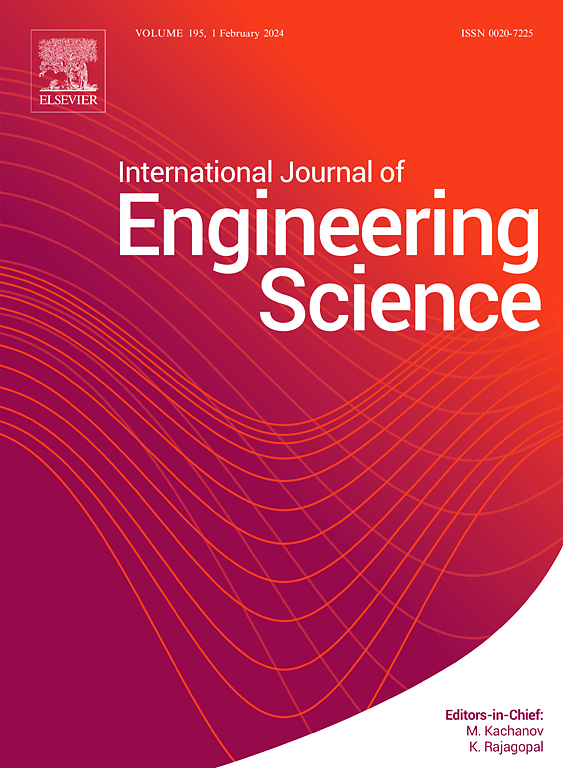General shape transformations of thin hyperelastic shells through stress-free differential growth
IF 5.7
1区 工程技术
Q1 ENGINEERING, MULTIDISCIPLINARY
International Journal of Engineering Science
Pub Date : 2025-04-16
DOI:10.1016/j.ijengsci.2025.104266
引用次数: 0
Abstract
To address the needs of engineering applications, researchers often wish that the shapes of samples can be precisely controlled. The current work aims to propose a promising approach, i.e., through stress-free differential growth, to realize general shape transformations of thin hyperelastic shells. First, within the finite-strain regime, we formulate the 3D governing equations system for modeling the growth behavior of hyperelastic shells. To facilitate the derivations, it is assumed that the shell sample attains the stress-free state in its current configuration. Subsequently, through series expansions of the unknown variables, we derive the explicit analytical formulas that elucidate the intricate relationships between growth functions and the geometric quantities of general 3D target surfaces. Based on these analytical formulas, we propose a theoretical framework for controlling the shape changes of the shell sample from the reference configuration to a desired target configuration. Notably, our framework accommodates a wide array of geometric mappings, including topology transformation, conformal mapping, and isometry mapping. To promote applications of the theoretical framework, a numerical scheme is further proposed to achieve shape transformations of shell samples between complex surfaces without explicit parametric equations. Both the theoretical framework and the numerical scheme are validated through 3D finite element simulations. The results of the current work can be applied for the design of novel intelligent soft devices, which also reveal the connections between solid mechanics and differential geometry.

通过无应力差分增长实现超弹性薄壳的一般形状变换
为了满足工程应用的需要,研究人员经常希望能够精确控制样品的形状。目前的工作旨在提出一种有前途的方法,即通过无应力微分生长,实现薄超弹性壳的一般形状转换。首先,在有限应变条件下,我们建立了三维控制方程组来模拟超弹性壳的生长行为。为了方便推导,假设壳样在其当前结构中达到无应力状态。随后,通过对未知变量的级数展开,推导出明确的解析公式,阐明了生长函数与一般三维目标曲面几何量之间的复杂关系。基于这些分析公式,我们提出了一个理论框架来控制壳体样品从参考构型到期望目标构型的形状变化。值得注意的是,我们的框架容纳了大量的几何映射,包括拓扑变换、保角映射和等距映射。为了促进理论框架的应用,进一步提出了一种无需显式参数方程即可实现壳样在复杂表面之间形状变换的数值格式。通过三维有限元仿真对理论框架和数值方案进行了验证。研究结果可应用于新型智能软装置的设计,揭示了固体力学与微分几何之间的联系。
本文章由计算机程序翻译,如有差异,请以英文原文为准。
求助全文
约1分钟内获得全文
求助全文
来源期刊

International Journal of Engineering Science
工程技术-工程:综合
CiteScore
11.80
自引率
16.70%
发文量
86
审稿时长
45 days
期刊介绍:
The International Journal of Engineering Science is not limited to a specific aspect of science and engineering but is instead devoted to a wide range of subfields in the engineering sciences. While it encourages a broad spectrum of contribution in the engineering sciences, its core interest lies in issues concerning material modeling and response. Articles of interdisciplinary nature are particularly welcome.
The primary goal of the new editors is to maintain high quality of publications. There will be a commitment to expediting the time taken for the publication of the papers. The articles that are sent for reviews will have names of the authors deleted with a view towards enhancing the objectivity and fairness of the review process.
Articles that are devoted to the purely mathematical aspects without a discussion of the physical implications of the results or the consideration of specific examples are discouraged. Articles concerning material science should not be limited merely to a description and recording of observations but should contain theoretical or quantitative discussion of the results.
 求助内容:
求助内容: 应助结果提醒方式:
应助结果提醒方式:


